ID:177 Development of a Resilient Community and Improving Disaster Education and Regional Disaster Preparedness
- Date
- 2015-03-14(Sat)
- Time
- 9:30-16:50(door open 9:00)
- Venue
- Tohoku University Mutimedia Hall
Report has released
- Capacity
- 500
- Language
- Japanese
- Translation
- Simultaneous interpretation
Contact/Entry
International Research Institute of Disaster Sciences, Tohoku University
Tel. 022-752-2104
Fax 022-752-2105
E-mail:sakurai*irides.tohoku.ac.jp (Please replace * to @)
http://www.bousai-edu.jp/jde-liaison-network/contact.html
Organization
Tohoku University International Research Institute of Disaster Sciences (IRIDeS)
Co-organization
Japan Association for Education on Disaster Risk Reduction
Disaster Education Japan Liaison Network for UNWCDRR
Disaster Management Bureau, Cabinet Office , Government of Japan
Ministry of Education, Culture, Sports Science and Technology-Japan
Tags
PDF file
Report
| Number of participants | 430 |
|---|
The symposium reviewed the past 20 years’ development of the Japanese disaster education and introduce efforts on disaster education and community-based disaster preparedness in the mega-earthquake disaster affected areas in Japan and the world, including the 2011 Great East Japan Earthquake, the 2008 Sichuan Earthquake, and the 2004 Indian Ocean Tsunami. At the end of the forum, Sendai Declaration on disaster education was adopted.
**********
Sendai Declaration on Disaster Education
Disaster education is the foundation of all the efforts for disaster risk reduction. The capacity of a society to accommodate itself to and recover from the effects of a natural disaster depends on how much each individual was able to learn from the past experiences and knowledge passed down from our ancestors, and how much they were able to prepare for a disaster in daily life through partnerships among households, schools, and the community. The goal of disaster education is to increase these capacities according to each indivisual’s level. We need to actively promote disaster education to save as many lives as possible in natural disasters and overcome difficult situations by cooperation with many people.
At today’s forum, we, various stakeholders concerned with disaster education in Japan and in the rest of the world, took this opportunity to interact with each other, introduced our diverse experiences, lessons and action, and agreed on the necessity of the improvement of regional disaster preparedness through disaster education with the cooperation of the whole community, in order to develop a resilient community with capacities to cope with and recover from disasters. We declare our dedication in the following actions based on our domestic and international networks, as well as in the promotion of the Post-HFA (Hyogo Framework for Action) that is to be adopted at the Third U.N. World Conference on Disaster Risk Reduction:
1. To cooperate domestically and internationally with areas that are affected by and at a risk of a disaster in the field of disaster risk reduction at schools and in local communities, support activities at schools and in local communities and share experiences, as well as foster the human resources of researchers and practitioners
2. To actively share the lessons learned from large-scale disasters in Japan, including the Great East Japan Earthquake and Tsunami, in regard to disaster risk reduction at schools and in local communities , for risk reduction of natural disasters in the world.
3. To contribute to research, implementation, promotion and improvment regarding disaster risk reduction actvities at schools and in local communities that can be carried out globally in cooperation with “Safe Schools” initiatives promoted by U.N. agencies and others and the Post-HFA.
4. To work on the development, implementation, promotion and improvment of “community-based” disaster education models for all citizens, including the use of disaster records, such as the disaster archives, in cooperation with Education for Sustainable Development (ESD), in order to develop a resilient community.
Downloads
Outline
The symposium will review the past 20 years’ development of the Japanese disaster education and introduce efforts on disaster education and community-based disaster preparedness in the mega-earthquake disaster affected areas in Japan and the world, including the Great East Japan Earthquake. The focus is to discuss how to enhance community resilience through education. Sendai Declaration on disaster education will be announced at the symposium.Detail
09:30-09:35
Opening Remarks
Masaki Watanabe, Vice Chair, Japan Disaster Education Network Liaison for UNWCDRR
09:35-09:55
【Invited Speech】
“20 Years’ development of Japanese disaster education evolved through lessons learned from mega-earthquake experiences”
Yoshio Toda, Representative, School Safety Education Study Support Center
Part I
Learning from Tohoku: Experiences of the Great East Japan Earthquake and Tsunami in 2011
09:55-10:10
“Initiatives for enhanced disaster education by MEXT”
Masahiro Oji, Director, School Health Education Unit, Sports and Health Department, Ministry of Education, Culture, Sports, Science and Technology
10:10-10:20
“Damage to and recovery of the education sector by the Great East Japan Earthquake and Tsunami”
Takeshi Sato, Professor, IRIDeS, Tohoku University
10:20-10:35
“Human development for reconstruction and revitalization”
Shinya Morimoto, Supervisor, Iwate Prefecture Board of Education
10:35-10:50
“Efforts for disaster education in Miyagi Prefecture”
Yuji Misaki, Supervisor, Miyagi Prefecture Board of Education
10:50-11:05
“Education recovery and disaster education program by Fukushima Prefecture Board of Education: Program for radiation education”
Hiroki Abe, Teacher’s Consultant, Fukushima Prefecture Board of Education
11:05−11:20
“Remodeled disaster education in Sendai”
Takashi Konno, Supervisor, Sendai City Board of Education
11:20-11:30
“Disaster recovery education program in Ishinomaki-City, Miyagi”
Aiko Sakurai, Associate Professor, IRIDeS, Tohoku University
11:30-11:40
“Science delivery and the Gensai Pocket Yui Project”
Mari Yasuda, Research Associate, IRIDeS, Tohoku University
11:40-11:50
“KAKEAGARE JAPAN” Tsunami disaster risk reduction joint project among industry, government and academia”
Yoshi Abe, Research Associate, IRIDeS, Tohoku University
11:50−12:00
“Disaster education on earthquake and tsunami with use of Disaster Mitigation Card Game”
Team of Top Leader Development Program in Global Safety, Leading Graduate School Program, Tohoku University
“The Making of Kamado Bench”(Shiga Prefecture)
Yoshinori Tanaka, Teacher, Shiga Prefecture Hikone Technical High School
“Lone Cherry Tree of Life Project”(Hyogo Prefecture)
Yoko Nakajima, Representative, Art School Atelier Taiyo-no-ko
12:00-13:00
Lunch Break and Exhibition Tour (@first floor lounge space)
Part II
Learning from Disaster Education Practices in the World and Japan
13:00-13:10
Remarks
Yoshiaki Nanami, Counselor, Disaster Management Bureau, Cabinet Office
13:10-13:35
“Disaster education after the 2004 Indian Ocean Tsunami in Banda Aceh, Indonesia”
Samsul Rizal, Rector Syiah Kuala University
Khairul Munadi, Head, Tsunami and Disaster Mitigation Research Center
Muhammad Dirhamsyah, Head, Graduate Program in Disaster Science
13:35-14:00
“School Safety in China after the 2008 Sichuan Earthquake”
Linsheng Gu, Professor, and Executive Director, Institute for Disaster Management and Deconstruction (IDMR), Sichuan University-Hong Kong Polytechnic University
14:00-14:10
Comment by Mee Young Choi, Head, Education Sector Unit, UNESCO Jakarta Office
14:10-14:25
“Great ShakeOut Earthquake Drills: Awareness to Action”
Dr. Mark Benthien, Director for Communication, Education and Outreach, Southern California Earthquake Center(USA)
14:25-14:34
“Great ShakeOut drill through collaboration between government and civic organization”
Masahiro Hamada, Representative, Zama Disaster Volunteer Network
14:34-14:43
“Implementation of disaster education based on various hands-on activities”
Yoshinori Takahashi, Principal, Minami-Yoshinari Elementary School, Sendai-City
14:43-14:52
“We are fighters for future disaster risk reduction”
Yasuyuki Toba, Teacher, Hashikami Junior High School, Kesennuma-City, Miyagi
14:52-15:01
“Safe disaster measures for mamas” Program
Masumi Nishizato, Representative, “Asobi ma・senka” Morioka-City, Iwate
15:01-15:10
“The Study of earthquake and tsunami in Shinjo and regional cooperation”
Akira Tanimoto, Shinjo Junior High School, Tanabe-City, Wakayama
15:10-15:19
“Disaster education to protect the lives and health of everyone”
Takeshi Takigawa, Teacher, Togane School for Special Needs Education, Chiba
15:19-15:28
From “Easy Japanese” to “Disaster education”
Atsuko Sugimoto “Easy Japanese” Volunteer Group, Kyoto
15:28-15:43
“Implementation handbook for regional disaster resilience education”
Haruo Hayashi, Professor, Disaster Prevention Research Institute, Kyoto University
15:45-15:55
Break
Part III
The Sendai Declaration and Panel Discussion
15:55-16:40
Coordinated by Yoshiaki Yazaki, Advisor, National School Safety Educational Study
Panelists:
Haruo Hayashi, Chair, Implementation Committee for Disaster Management Education Challenge Plan
Masaki Watanabe, President, the Japanese Association of Safety Education
Naoshi Hirata, Chair, Association of Disaster Education Promotion
Fumihiko Imamura, Chair, Drafting Committee on Sendai Declaration
Tatsuya Fujioka, Vice Chair, Drafting Committee on Sendai Declaration
16:40-16:50
Announcement of Sendai Declaration and Closing Remarks
Fumihiko Imamura, Director and Professor, IRIDeS, Tohoku University and Chair, Japan Disaster Education Network Liaison for UNWCDRR
16:50-17:50
Exhibition Tour and Information Exchange @first floor lounge
18:00-20:00
Reception @Café couleur, Kawauchi Campus, Tohoku University


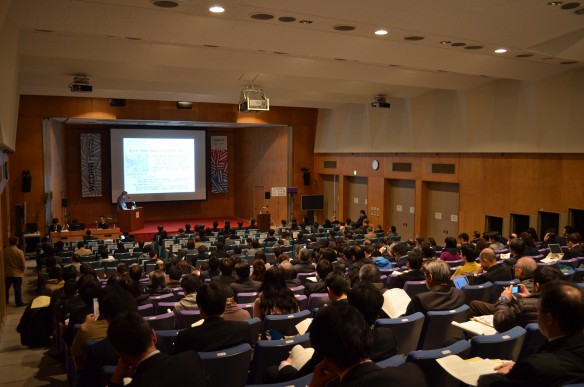
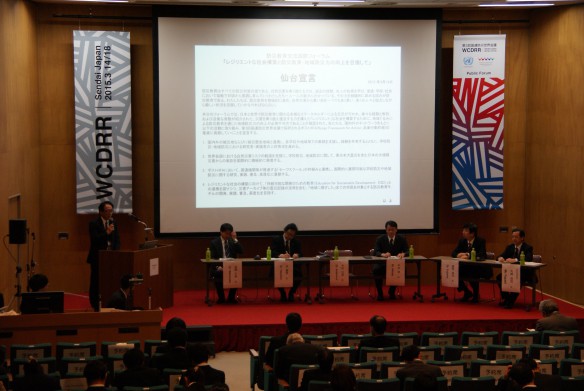
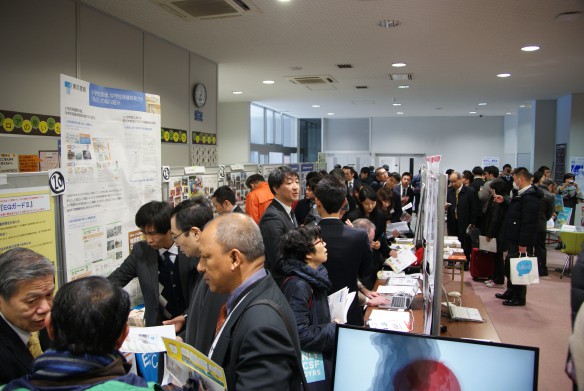

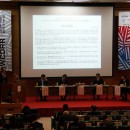
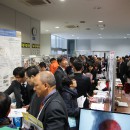
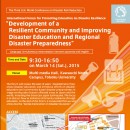 Flyer
Flyer

